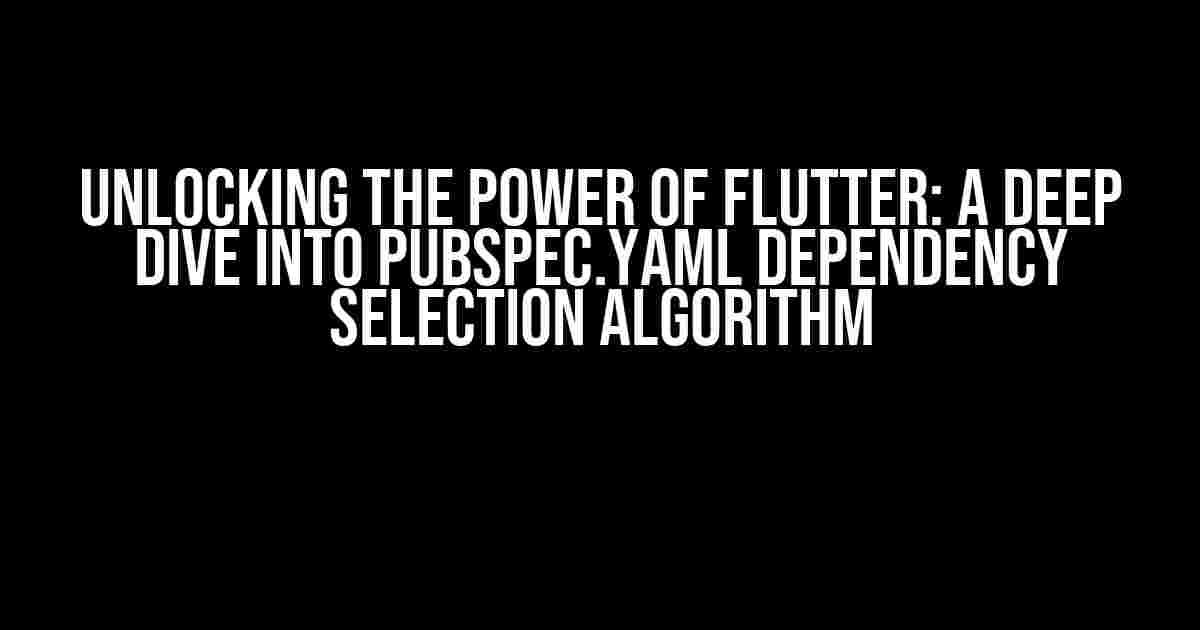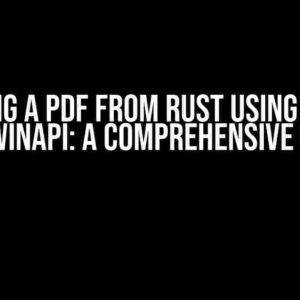Are you tired of dealing with pesky dependency issues in your Flutter projects? Do you find yourself wondering how to optimize your pubspec.yaml file for seamless package management? Look no further! In this article, we’ll delve into the intricacies of Flutter’s pubspec.yaml dependency selection algorithm, providing you with the knowledge to take your development skills to the next level.
What is Pubspec.yaml?
Pubspec.yaml is the heart of every Flutter project, serving as the central configuration file for package management. It’s where you declare your project’s dependencies, versions, and other essential metadata. However, with great power comes great responsibility – mastering pubspec.yaml is crucial for ensuring your project’s stability and performance.
The Anatomy of Pubspec.yaml
name: my_app
version: 1.0.0
environment:
sdk: ">=2.12.0 <3.0.0"
dependencies:
flutter:
sdk: flutter
http: ^0.13.3
path_provider: ^2.0.2
In the above example, we have a basic pubspec.yaml file with the following components:
name: The name of your project.version: The version number of your project.environment: Specifies the SDK version range for your project.dependencies: A list of packages required by your project, along with their respective versions.
Understanding the Dependency Selection Algorithm
Flutter’s dependency selection algorithm is a complex process that determines the best package versions to use for your project. Here’s a step-by-step breakdown:
- Resolve dependencies: When you run
flutter pub get, the algorithm starts by resolving the dependencies listed in your pubspec.yaml file. - Check version constraints: The algorithm checks the version constraints for each dependency, ensuring that the selected version meets the specified requirements.
- Verify compatibility: The algorithm verifies that the selected package versions are compatible with each other and with the project’s SDK version.
- Select the best version: If multiple versions of a package meet the constraints, the algorithm chooses the highest version that satisfies all dependencies.
- Resolve conflicts: In case of conflicts between dependencies, the algorithm attempts to find a resolution by selecting alternative versions or adjusting the dependency graph.
Version Solving Strategies
The dependency selection algorithm employs two version solving strategies:
| Strategy | Description |
|---|---|
| Topological Sorting | This strategy resolves dependencies by sorting them in a topological order, ensuring that each package is only considered once. |
| Knapsack Algorithm | This strategy uses a knapsack algorithm to efficiently find the optimal set of package versions that satisfy all dependencies. |
Best Practices for Dependency Management
To ensure seamless package management and optimize your pubspec.yaml file, follow these best practices:
- Use caret (^) syntax: Specify version ranges using the caret syntax (e.g.,
http: ^0.13.3) to allow for minor version updates. - Keep dependencies up-to-date: Regularly update your dependencies to ensure you have the latest security patches and features.
- Avoid conflicting dependencies: Be cautious when adding new dependencies to avoid version conflicts and compatibility issues.
- Use dependency_override: Utilize the
dependency_overridedirective to specify alternative versions for dependencies that conflict with each other. - Test and verify: Thoroughly test your project after updating dependencies to ensure compatibility and stability.
Common Pubspec.yaml Mistakes to Avoid
Avoid these common mistakes to prevent issues with your pubspec.yaml file:
- Inconsistent versioning: Ensure that all dependencies have consistent versioning (e.g., using both
^and~syntax). - Omitting environment constraints: Always specify environment constraints to ensure compatibility with the project’s SDK version.
- Ignoring dependency conflicts: Address dependency conflicts promptly to prevent issues and ensure project stability.
- Over-specifying versions: Avoid over-specifying versions, as this can lead to dependency conflicts and limit future updates.
Conclusion
In conclusion, mastering Flutter’s pubspec.yaml dependency selection algorithm is crucial for efficient package management and project stability. By understanding the algorithm’s inner workings and following best practices, you’ll be well-equipped to tackle even the most complex dependency issues. Remember to stay vigilant and regularly update your dependencies to ensure your project stays on the bleeding edge of Flutter development.
Now, go forth and unlock the full potential of your Flutter projects with a solid grasp of pubspec.yaml dependency selection algorithm!
Here are 5 Questions and Answers about “Flutter pubspec.yaml dependency selection algorithm” in a creative voice and tone:
Frequently Asked Question
Get ready to dive into the world of Flutter’s pubspec.yaml dependency selection algorithm!
What is the pubspec.yaml dependency selection algorithm in Flutter?
The pubspec.yaml dependency selection algorithm is a set of rules that Flutter uses to resolve dependencies in your pubspec.yaml file. It’s like a referee that makes sure all the dependencies play nice with each other, ensuring that your app builds and runs smoothly!
How does the algorithm handle version conflicts between dependencies?
When there’s a version conflict, the algorithm uses a “highest version wins” strategy. It selects the highest compatible version that satisfies all dependencies. Think of it like a negotiation between dependencies, where the algorithm finds a common ground that works for everyone!
What is the difference between `^` and `~` in version constraints?
The `^` symbol indicates a “caret” constraint, which allows for updates to the minor version, while the `~` symbol indicates a “tilde” constraint, which allows for updates to the patch version only. Think of `^` as a more relaxed, “go with the flow” approach, while `~` is more strict, “stick to the plan”!
How does the algorithm handle dependencies with multiple constraints?
When there are multiple constraints, the algorithm combines them using a logical AND operation. It’s like a filter that narrows down the possible versions until it finds the one that satisfies all constraints. It’s a clever way to ensure that all dependencies are happy and compatible!
Can I customize the dependency selection algorithm in Flutter?
While you can’t customize the algorithm itself, you can influence its behavior by specifying version constraints and overrides in your pubspec.yaml file. It’s like guiding the algorithm to make the right decisions for your app’s specific needs!




